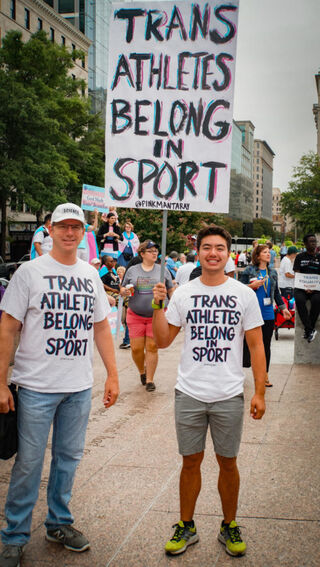Transgender
Trans Youth in Sports: What's the Big Deal?
How to respond to common myths and misconceptions.
Posted July 14, 2021 Reviewed by Jessica Schrader
Key points
- Sports programs in K-12 schools are considered part of basic “educational opportunities” and are subject to civil rights laws.
- If school sports are regulated to keep them “fair” and “safe,” then height and weight limits for contact sports could be proposed.
- By blocking young people who already experience significant obstacles due to transphobia, we deny them valuable experiences.
As 36 different states have considered legislation that would ban or seriously restrict opportunities for transgender youth to participate in school sports,1 this week Catherine Lhamon is going through her confirmation hearings to become director of President Biden’s Office for Civil Rights, and so the question of transgender youth participation in school sports is in the media again.
In this post, I am going to focus on participation in sports in K-12 schools since the NCAA and the International Olympic Committee both have clear policies on participation for transgender athletes and there are nine known trans athletes aiming for a spot in this year’s Tokyo Games. I want to distinguish between elite sports competition and general K-12 sports programs. In elite competition, all of the athletes are exceptional in some way—they are the best in their country or state. This is often due to different kinds of naturally occurring variations in human physiology and the environmental supports they have access to in order to train and be competitive at such a high level. Consider Simone Biles, Michael Phelps, Lebron James, Katie Ledecky, or Serena Williams. They're all exceptional in different ways and that's what we celebrate when they win—their exceptionality. Trans athletes don’t have any different kind of advantage than these athletes whose naturally occurring variations in their bodies make them ideally suited for excellence in their sport. This idea of unfair competitive advantage has been disproven by many scientists2.

However, my focus here is on trans athletes and K-12 sports participation in schools. It is important to understand that sports programs are considered as part of the “educational opportunities” offered by schools and are subject to civil rights laws. They are an important part of a school community and we know that sport offers different kinds of learning and development that benefit and keep youth engaged at school much like music and arts programs. We know from years of research that sports provide kids both physical and psychosocial benefits, including improved bone health, weight, cardiorespiratory and muscular fitness, cognitive function, and a reduced risk of depression as well as higher levels of perceived competence, confidence, and self-esteem; reduced risk of suicide and suicidal thoughts and tendencies; and improved life skills, such as goal setting, time management, and work ethic. Additionally, youth can develop social and interpersonal skills, such as teamwork, leadership, and relationship building3. As such, from both a legal and ethical perspective, if sports programs are available to some students in a school community, they should be available to all students.
So what does this mean for trans girls? I am addressing the issue of trans girls in particular, since there is relatively minimal concern expressed about trans boys. This is likely because there's not a perception that higher levels of estrogen make you stronger or faster. So, athletes who were assigned female at birth aren't seen as much of a threat in the athletic arena—except to the perceived masculinity of the other male athletes they are competing against. In any case, with trans girls, most of them are prescribed hormone blockers, or puberty suppression medication, by their endocrinologists once they start puberty. This is to help them “pause” puberty so their bodies don’t go through masculinizing changes that would cause them mental distress. As such, they won’t have higher or elevated levels of testosterone that would put them in a category of having some kind of physical advantage—which, as noted above, has not been proven to exist. However, I do want to point out that there are athletes who have naturally occurring height or size advantages and we don’t exclude them—even though they pose some physical danger to the other athletes. If we want to regulate school sports to keep them “fair” and “safe,” then propose height and weight limits to athletes in sports that may involve contact. For example: you can’t play football, hockey, basketball, or soccer if you’re over 6-foot or weigh more than 200 pounds. This would make school sports safer and more fair, but no one is seriously proposing such a restriction.
My argument here is that youth sports are healthy and beneficial to all youth. Most kids just want to have a social activity with their peers and being part of a team provides an important source of belonging, community, and connection that can be a part of healthy adolescent development. Having a broader set of adult mentors and role models is another benefit youth get by being part of an athletic team. School teams are often more about participation than high levels of competition. By blocking young people who already experience significant obstacles due to transphobia in our schools and culture (harassment, exclusion, violence4), we are preventing them from a valuable—and potentially life-saving—set of experiences.
This post has not even addressed the challenges faced by agender, gender-fluid, and non-binary youth. People who do not identify within the binary (as a girl or boy) experience different barriers and marginalization since there are not even facilities or programs designed for them. We need to think more about how to make spaces for this growing segment of the population. In the meantime, please consider speaking up in your community to challenge the harmful laws and narratives circulating about transgender athletes.
Here are some resources for supporting transgender equality:
References
Endnotes:
1. https://freedomforallamericans.org/legislative-tracker/student-athletics/
2. https://www.npr.org/2021/03/18/978716732/wave-of-new-bills-say-trans-athletes-have-an-unfair-edge-what-does-the-science-s ; https://www.scientificamerican.com/article/trans-girls-belong-on-girls-sports-teams/
3. https://health.gov/sites/default/files/2019-10/National_Youth_Sports_Strategy.pdf
4. https://www.glsen.org/research/harsh-realities-experiences-trans-youth-schools


